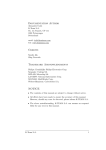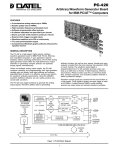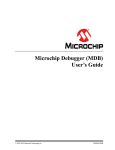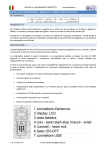Download K-Junior Operating System Manual - K
Transcript
K-JUNIOR
K-Junior v2 OS
MANUA
MANUAL
Usage
Usage and Functions
unctions
February 2012 Edition
K-JUNIOR
K-Junior v2 OS Manual, Usage and functions - page 1 -
K-JUNIOR
NOTICE
The information included in this manual is subject to change without prior notice.
K-Team cannot be held responsible for any technical or writing omissions, nor any consequent damage
that may arise.
In the same way, the product names mentioned in this manual and in the CD-Rom for identification
purposes may be trademarks, whether registered or not, belonging to their respective owners.
K-JUNIOR
K-Junior v2 OS Manual, Usage and functions - page 2 -
K-JUNIOR
Table of contents
CHAPTER 1 : INTRODUCTION ……………………………...........................
Page 5
CHAPTER 2 : THE COMPILER …...............................................................
Page 6
CHAPTER 3 : USING THE C COMPILER (PCW CCS) …….......…….........
Page 7
CHAPTER 4 : USING THE K-JUNIOR UPLOADER ………...….................
4.1 – Safety usage……………….. ……....……..............................
4.2 – Reload the « Bootloader » ….……………............................
Page 8
Page 8
Page 8
CHAPTER 5 : KJUNIOR OS ………………………………….……...…........
5.1 – What’s that?.……....…….....................................................
5.2 – Its structure …………………………………….......................
Page 9
Page 9
Page 9
CHAPTER 6 : FUNCTIONS ……………………………….……...….......
6.1 – Definition …………….….......…….........................................
6.2 – Configuration functions of the robot. ……….........................
6.3 – « Flags » reading function....................................................
6.4 – Input and Output functions……………………….. .............
6.5 – Delay and « Timer » functions...….………………….…….....
6.6 – I/O functions of the external connectors..............................
6.7 – Real time tasks……………………………….........................
6.8 – C compiler specific functions…………... .….........................
Pages 10 - 17
Page 10
Page 11
Page 12
Pages 13 - 14
Page 15
Page 16
Page 17
Page 17
CHAPTER 7 : EXAMPLES ………..…………………………….……...…........
Page 18
CHAPTER 8 : MODULES LIBRARIES ……………….………..…..................
8.1 – Definition ……………….….......….........................................
8.2 – Functions of the « I/O interface board » module…...............
8.3 – Functions of the « Ultrasonic detector» module…...............
8.4 – Functions of the « Linear camera » module……..................
8.5 – Functions of the « Vocal synthesizer» module…...…….......
8.6 – Functions of the « LCD screen» module……..…...…….......
8.7 – Functions of the « Gripper» module……..…...…….......
Pages 18 - 24
Page 19
Page 20
Page 21
Pages 22 - 23
Page 24
Page 24 - 26
Page 27 - 29
APPENDIX
Page 30
K-JUNIOR
K-Junior v2 OS Manual, Usage and functions - page 3 -
K-JUNIOR
White page for
writing your
personal notes
K-JUNIOR
K-Junior v2 OS Manual, Usage and functions - page 4 -
K-JUNIOR
1 – INTRODUCTION
K-Junior is provided with a processor from Microchip, the PIC18F66k22.
This processor is used in many applications; therefore there is already a big community with many
users.
Microchip provides a free assembler for the PICs. But this low-level language is not well suitable for
a fast development in robotics. It is rather a specific language for the low-level layers.
In this manual we will introduce the particular case of C language to you, which is to our opinion the
most suitable.
The whole K-Junior OS (« Operating System », embedded system on the K-Junior) was developed in
this language. We distribute the source codes under the LGPL license, which means that you can
use it freely and without restraint (except for commercial purpose).
Let’s see more in detail the programming part.
This document is suitable for people having already some basic knowledge in C language.
K-JUNIOR
K-Junior v2 OS Manual, Usage and functions - page 5 -
K-JUNIOR
2 – THE COMPILER
Nowadays there are on the market many C compilers for PIC micro-processors on the market, more
or less expensive but also more or less reliable.
After having tested many among others, K-Team recommends the « PCH » C compiler from CCS for
its quality, support and price ratio and is multi-platforms support. It is one among the best in the
market: it comprises many high-level integrated functions along with a friendly user interface.
Following commercial agreements with CCS, you can obtain a specific version of the PWC compiler,
including a compiler/debugger (limited to the PIC18F66k22) and an editor in full version.
You can obtain this version of the PCH compiler by contacting K-Team.
If you wish, you can obtain an external PIC « ICD_U » programmer to program again the
microprocessor.
Currently we do not assure any support for another C compiler.
If you already have another C compiler for PIC,
you need to adapt the source code of the « K-Junior OS ».
K-JUNIOR
K-Junior v2 OS Manual, Usage and functions - page 6 -
K-JUNIOR
3 – USAGE OF THE PIC C COMPILER
The following steps are required to install the PIC C compiler from CCS:
- create a directory « PICC » in the directory « Program Files » of Windows ;
- In this directory copy the licence « pcm.crg » you received;
- Run the setup file « SetupPcw.exe » you received or available in the directory « PCW CCS »
of the CD-ROM « Installation Professor » delivered with the DIDAPACK from K-TEAM.
When the install procedure is finished, you may modify and compile the K-Junior OS as follows :
- Copy on your PC the directory « K-JuniorOS_Sources » from the Support CD-ROM or
download the last version on the K-Team web site.
- start the PIC C compiler (short-cut on the Windows desktop or in the menu bar « Start /
Programmes / PIC-C » ;
- Click on « Project » then « Open » and select the file « KJOs.pjt » in the directory « KJuniorOS / K-JuniorOS_Sources » copied in your PC;
- Click on « Project » then « Open » and select the file « KJOs.c » ;
- Add your code ;
- Click on the object « compile » or press the F9 key of your keyboard to compile.
If there is no error in your code, the compiler will generate a file « KJOs.hex », compiled program that
can be uploaded with the « K-Junior Uploader » into K-Junior (see next CHAPTER).
K-JUNIOR
K-Junior v2 OS Manual, Usage and functions - page 7 -
K-JUNIOR
4 – USAGE OF THE K-JUNIOR UPLOADER
Once your program is compiled, find the file « KJOs.hex » created by the compiler.
Use the « K-Junior Uploader » to upload this OS (compiled program) into the « Flash » memory of
the microprocessor of the K-Junior robot.
With the "K-Junior Uploader", you can upload a program through the USB serial port into the
microprocessor of the K-Junior robot.
Please refer to the K-Junior UserManual to configure the Uploader software (see section 5.1).
The data (program uploading) sent from the "K-Junior Uploader" are processed and saved by a
software named "KJ-Bootloader" that K-Team loaded into the Flash memory of the PIC when the KJunior was assembled.
4.1 Safety usage
A bad manipulation may erase the "Bootloader" program from the memory.
In this case, the upload through the USB serial port will not be possible anymore (usage "K-Junior
Uploader").
If you load a program you compiled (C compiler, Assembly, etc.), make sure you respect following
rule:
The memory zone from 0x1F00 to 0x1FFF ("Bootloader" reserved zone)
must never be written.
The compiled filed (".hex") issed from K-TEAM respect this rule.
If you erase by mistake this memory zone during a bad manipulation and you have an external
programmer, reload the "KJ-Bootloader.hex" file included in your K-Junior Support CD-ROM (see
next CHAPTER).
Refer to the K-Junior Uploader section in the K-Junior UserManual of the CD-ROM to do this upload.
4.2 Reloading the « BootLoader » by the means of an external programmer
If you have a serial programmer for the PIC18F66k22 microprocessor (« PicStart © » from Microchip
or « ICD-U » from CCS for example) you can reflash the memory of the K-Junior’s PIC and reload the
"KJ-Bootloader.hex" file included in the K-Junior Support CD-Rom or on the K-team website and
recover the serial upload functionality.
K-JUNIOR
K-Junior v2 OS Manual, Usage and functions - page 8 -
K-JUNIOR
5. K-JUNIOR OS
5.1 What’s that?
We can say that:
« K-Junior OS is for K-Junior, what Windows or Linux is for your PC ».
The K-Junior OS manages the resources of K-Junior and it enables you to access the embedded
hardware.
5.2 It’s structure
The source code of the K-Junior OS can be found on the K-junior Support CD-Rom or on the K-Team
web site under Support->Download->K-Junior.
This OS is composed of several files :
- « KJOs.c », main file containing the « main » ; in this file, you declare your variables, your
functions and you write your code;
- « KJunior.c », file containing the sources of the control and access function to the K-Junior
robot hardware (*) ;
- « KJunior.h », file containing the functions prototypes you use and the K-Junior parameters
(quartz frequency, baudrate...) (*) ;
- « 18f66k22.h », file containing the registers addresses of the processor (*) ;
- « variables.c », file containg the internal variables (*) ;
- « constants.h », file containing the constants definitions (*) ;
- « versions.txt », description of the modifications done at every version.
(*) : these files must not be modified by “ordinary” users programming the behaviours of K-Junior, but
“expert” users who would like to modify and improve the functions of « K-Junior OS ».
Other files are available in the directory « Libs » for using the extension modules (I/O interface board,
linear camera, Gripper, etc.).
K-JUNIOR
K-Junior v2 OS Manual, Usage and functions - page 9 -
K-JUNIOR
6 – FUNCTIONS
6.1 Definition
Here’s a small explanation before starting with the list of the available functions for the K-Junior OS.
General notation of the available functions « a = f( b ); »
- a is the returned value;
- f is the function;
- b is the parameter;
Variable notations:
- char is a 8bits signed integer variable, 1 octet (-128 to 127) ;
- unsigned char is a 8 bits unsigned variable, 1 octet (0 to 255) ;
- int1 is a bit variable (boolean, 0 or 1) ;
- int is a 16bits signed integer variable (-32768 to 32767) ;
- unsigned int is a 16bits unsigned integer variable (0 to 65535) ;
- unsigned int16 is a 16bits unsigned integer variable (0 to 65535) ;
- signed int8 is a 8bits signed integer variable (-128 to 127) ;
K-JUNIOR
K-Junior v2 OS Manual, Usage and functions - page 10 -
K-JUNIOR
6.2 Configuration functions of the robot
void KJunior_init( void )
Goal :
Initialize KJunior
Parameter : None
Return :
Nothing
Example : KJunior_init();
Notice :
This function must be at the beginning of every program to initialize the KJunior robot
with this default configuration:
- automatic reading of the IR sensor activated
- RS232 management activated
- Automatic reading of the TV receiver activated
- TV remote control activated.
void KJunior_config_auto_refresh_sensors( int1 Bit )
Goal :
Configure the IR sensor reading
Parameter : MANUAL or REFRESH (by default)
Return :
Nothing
Example : KJunior_config_auto_refresh_sensors( MANUAL );
Notice :
This function configures if the automatic reading of the IR sensors are activated
(parameter REFRESH) or not (parameter MANUAL).
void KJunior_config_auto_refresh_tv_remote( int1 Bit)
Goal :
Configure the automatic reading of the TV remote receiver.
Parameter : MANUAL or REFRESH (by default)
Return :
Nothing
Example : KJunior_config_auto_refresh_tv_remote( MANUAL );
Notice :
This function configures if the TV remote receiver is refreshing automatically (Parameter
REFRESH) or not (Parameter MANUAL).
void KJunior_config_rs232_control( int1 Bit)
Goal :
Activate or note the "Serial Remote Control"
Parameter : DISABLE or ENABLE(by default)
Return :
Nothing
Example : KJunior_config_rs232_control( DISABLE );
Notice :
This function activates (parameter ENABLE) or not (parameter DISABLE) the RS232
"Serial Remote Control".
Warning: if this mode is activated, you can use the “printf” function (i.e. to view some values with a
terminal) Goal you can’t read anything from the serial port (getc, gets, etc.. are not available), all the
data will be read by the “Serial Remote Control” process.
void KJunior_config_tv_remote_control( int1 Bit)
Goal :
Activate or not the "TV Remote Control" mode
Parameter : DISABLE or ENABLE(by default)
Return :
Nothing
Example : KJunior_config_tv_remote_control( DISABLE );
Notice :
This function activates (parameter ENABLE) or not (parameter DISABLE) the “TV
Remote Control” mode (remote control of the motors with a TV remote).
K-JUNIOR
K-Junior v2 OS Manual, Usage and functions - page 11 -
K-JUNIOR
6.3 « Flags » reading function
int1 KJunior_flag_sensors_refreshed( void )
Goal :
Parameter :
Return :
Example :
Notice :
To know if the IR sensors were refreshed
None
The bit is set if the sensors just have been refreshed.
i = KJunior_flag_sensors_refreshed();
You must reset the flag after with the « KJunior_flag_sensors_reset » function.
void KJunior_flag_sensors_reset( void )
Goal :
Reset the IR sensor flag
Parameter : None
Return :
Nothing
Example : KJunior_flag_sensors_reset();
int1 KJunior_flag_rs232_filtering( void )
Goal:
Parameter :
Return :
Example :
To know if the “Serial Remote Control” mode is activated or not
None
1 if the mode is activated and 0 if not.
i = KJunior_flag_rs232_filtering();
int1 KJunior_flag_tv_data_refreshed( void )
Goal:
Parameter :
Return :
Example :
Notice :
To know if the TV receiver was refreshed or not.
None
1 if some data was received on the TV receiver.
i = KJunior_flag_tv_data_refreshed();
You must reset the flag after with the “KJunior_flag_tv_data_reset” function.
int1 KJunior_flag_tv_data_emitting( void )
Goal:
Parameter :
Return :
Example :
To know if the emitting is complete or not.
None
1 if some data are still emitting or 0 it’s done
i = KJunior_flag_tv_data_emitting();
void KJunior_flag_tv_data_reset( void )
Goal :
Parameter :
Return :
Example :
Reset the TV receiver flag.
None
None
KJunior_flag_tv_data_reset();
K-JUNIOR
K-Junior v2 OS Manual, Usage and functions - page 12 -
K-JUNIOR
6.4 Input and Output functions
Signed int16 KJunior_get_proximity( char Sensor )
Goal :
Get the value of the proximity sensor
Parameter : FRONT, FRONTLEFT, FRONTRIGHT, LEFT, RIGHT, REAR, GROUNDLEFT,
GROUNDRIGHT, GROUNDFRONTLEFT, GROUNDFRONTRIGHT
Return :
Example :
sensor.
12bits value ( 0(nothing) to 4095(an obstacle is very near) )
i = KJunior_get_proximity( FRONT ); Return the proximity value of the “Front” IR
signed int16 KJunior_get_brightness( char Sensor )
Goal :
Get the brightness value of a IR sensor.
Parameter : FRONT, FRONTLEFT, FRONTRIGHT, LEFT, RIGHT, REAR, GROUNDLEFT,
GROUNDRIGHT, GROUNDFRONTLEFT, GROUNDFRONTRIGHT
Return :
Example :
sensor.
12 bits value ( 0(dark) to 4095(big luminosity))
i = KJunior_get_brightness( REAR ); Return the brightness value of the “Rear”
unsigned char KJunior_get_switch_state( )
Goal :
Parameter :
Return :
Example :
Read the state of the dip switch
None
0 (all switch turn Off) to 7 (all switch On).
i = KJunior_get_switch_state( ); Return the state of the Dip switch
unsigned char KJunior_get_tv_data( void )
Goal :
Get the data received on the TV receiver.
Parameter : None
Return :
6 bits value ( 0 to 63 )
Example : i = KJunior_get_tv_data(); Return the coded value of the pressed TV remote button
or from another K-Junior. i.e. the value will be 2 if the button 2 of the numeric pad is pressed.
unsigned char KJunior_get_tv_addr( void )
Goal :
Get the address received on the TV receiver.
Parameter : None
Return :
5 bits value ( 0 to 31 )
Example : i = KJunior_get_tv_addr(); Return the address of the TV remote or of another KJunior. i.e. the value will be 2 if another K-Junior send a command like
“KJunior_send_tv_value(2.10)”
void KJunior_send_tv_value( unsigned char addr, unsigned char data )
Goal :
Send a data and an address value on the IR emitter using the RC5 code
Parameter : addr (0 to 31), data (0 to 63)
Return :
Nothing
Example : KJunior_send_tv_value(2,10); Send a message on the IR emitter with an address
of 2 and a Data of 10. Every closest K-Junior will received this message.
K-JUNIOR
K-Junior v2 OS Manual, Usage and functions - page 13 -
K-JUNIOR
void KJunior_set_speed( signed int8 LeftSpeed, signed int8 RightSpeed)
Goal :
Set the speed of the motor left (first value) and right (second value)
Parameter : -20 to 20 ( 0 = Stop )
Return :
None
Example : KJunior_set_speed( 5 , -5 ); set a speed of +5 on the left motor and -5 on the right
motor. The robot will turn on itself in this example.
Notice :
The PWM command has a fixed frequency of 20kHz and variable duty cycle from 0 to
100% fixed by the consigne, where 20 set a PWM ratio of 100%.
void KJunior_beep( unsigned char Freq)
Goal :
Make a continuous sound with the « Buzzer » at the selected frequency sound
Parameter : Frequency (0 to 48) where 0 is Off and 48 is 1.975kHz
Return :
None
Example : KJunior_beep( 13 ); Make a sound of 262Hz (Do) on the « Buzzer » of the KJunior.
Please refer to section 3.2.3 in the K-Junior user manual to calculate the corresponding frequency.
void KJunior_led_left( int1 State)
Goal :
Parameter :
Return :
Example :
Turn ON or OFF the LED “Left”
ON (1) or OFF (0)
None
KJunior_led_left( ON ); Turn ON the “Left” LED of the robot.
void KJunior_led_frontleft( int1 State)
Goal :
Parameter :
Return :
Example :
Turn ON or OFF the LED “Front Left”
ON (1) or OFF (0)
None
KJunior_led_frontleft( ON ); Turn ON the “Front Left” LED of the robot.
void KJunior_led_frontright( int1 State)
Goal :
Parameter :
Return :
Example :
Turn ON or OFF the LED “Front Right”
ON (1) or OFF (0)
None
KJunior_led_frontright( ON ); Turn ON the “Front Right” LED of the robot.
K-JUNIOR
K-Junior v2 OS Manual, Usage and functions - page 14 -
K-JUNIOR
void KJunior_led_right( int1 State)
Goal :
Parameter :
Return :
Example :
Turn ON or OFF the LED “Right”
ON (1) or OFF (0)
None
KJunior_led_right( ON ); Turn ON the “Right” LED of the robot.
void KJunior_led_onoff( int1 State)
Goal :
Parameter :
Return :
Example :
Turn ON or OFF the LED « On/Off »
ON (1) or OFF (0)
None
KJunior_led_onoff( ON ); Turn ON the « On/Off » of the robot.
void KJunior_manual_refresh_sensors()
Goal :
Refresh manually the IR sensors.
Parameter : None
Return :
None
Example : KJunior_manual_refresh_sensors(); refresh the value of the IR sensors.
Notice :
This function is useful only after disabling the automatic refresh sensor mode with the
function « KJunior_config_auto_refresh_sensors ».
Then use one of the two functions to read the IR sensors (« KJunior_get_proximity » or
« KJunior_get_brightness »).
unsigned int16 KJunior_get_Battery( )
Goal :
Parameter :
Return :
Example :
Read the Battery Voltage of the K-Junior
None
0 (all switch turn Off) to 7 (all switch On).
i = KJunior_get_switch_state( ); Return the state of the Dip switch
K-JUNIOR
K-Junior v2 OS Manual, Usage and functions - page 15 -
K-JUNIOR
6.5 Delay and « Timer » functions
void KJunior_delay_s( unsigned int Delay)
Goal :
Parameter :
Return :
Example :
Put a delay in second (temporization).
Time to wait in seconds ( 0 to 65535)
None
KJunior_delay_s( 120 ); Wait 2 minutes.
void KJunior_delay_ms( unsigned int Delay)
Goal :
Parameter :
Return :
Example :
Put a delay in millisecond (temporization).
Time to wait in ms ( 0 to 65535 )
None
KJunior_delay_ms( 5000 ); Wait 5s.
void KJunior_delay_us( unsigned int Delay)
Goal :
Parameter :
Return :
Example :
Put a delay in microsecond (temporization).
Time to wait in us ( 0 to 65535)
None
KJunior_delay_us( 500 ); wait 500 us.
A 32 bits timer provides the time (in millisecond) elapsed since the robot is turned on.
unsigned int32 KJunior_get_time( void )
Goal :
Parameter :
Return :
Example :
Get the value of the elapsed time in ms.
None
Unsigned int32 ( 0 to 4294967295 )
Timer = KJunior_get_time(); Timer = elapsed time in ms.
void KJunior_set_time(unsigned int32 Time)
Goal :
Parameter :
Return :
Example :
Initialize or force the elapsed time of the timer for the « KJunior_get_time » function.
Unsigned int32 ( 0 to 4294967295 )
None
KJunior_set_time(0); Initialize the timer to 0 ms.
K-JUNIOR
K-Junior v2 OS Manual, Usage and functions - page 16 -
K-JUNIOR
6.6 I/O functions of the external connectors
int1 KJunior_ext_read_PINB6( void )
Goal :
Read the digital Input/Output RB6 of the microcontroller.
Parameter : None
Return :
0 or 1
Example : i = KJunior_ext_read_PINB6();Return the state (0 or 1) of RB6 pin.
Notice :
This Input/Output is connected to the external connector “Power supply and I2C Bus”
(see KJunior schematics).
int1 KJunior_ext_read_PINB7( void )
Goal :
Read the digital Input/Output RB7 of the microcontroller.
Parameter : None
Return :
0 or 1
Example : i = KJunior_ext_read_PINB7();Return the state (0 or 1) of RB7 pin.
Notice :
This Input/Output is connected to the external connector “Power supply and I2C Bus”
(see KJunior schematics).
void KJunior_ext_write_PINB6( int1 Bit )
Goal :
Set the value of the digital output RB6 of the microcontroller.
Parameter : 0 or 1
Return :
None
Example : i = KJunior_ext_write_PINB6(1); set the RB6 pin to 1 (+5V)
Notice :
This Input/Output is connected to the external connector “Power supply and I2C Bus”
(see KJunior schematics).
void KJunior_ext_write_PINB7( int1 Bit )
Goal :
Set the value of the digital output RB7 of the microcontroller.
Parameter : 0 or 1
Return :
None
Example : i = KJunior_ext_write_PINB7(1); set the RB7 pin to 1 (+5V)
Notice :
This Input/Output is connected to the external connector “Power supply and I2C Bus”
(see KJunior schematics).
K-JUNIOR
K-Junior v2 OS Manual, Usage and functions - page 17 -
K-JUNIOR
6.8 C compiler specific functions
Like any C compiler, the CCS compiler has a very big set of functions in addition of the « ANSY »
functions, like the I2C bus access, random number generation, delay, etc…
You can find the details of these functions in the user manual of the CCS compiler.
K-JUNIOR
K-Junior v2 OS Manual, Usage and functions - page 18 -
K-JUNIOR
7 – EXAMPLES
Many examples with comments are available (free to use in your project) in the support CD-rom.
A RTF file « KJuniorGlossaireFonctionsC.rtf » are available too in the
« KJuniorOS/KJuniorOS_Sources » directory, it allows you to quickly choose the needed function
and to copy it to your code (See the C compilation tutorial in the « programming tools»
Section of the CD-rom.
8 – MODULES LIBRARIES
8.1 Definition
As the Hemisson turrets are compatible with the K-Junior, all the turrets libraries are compatible too.
Then all the following functions have the same named as the Hemisson turrets functions.
In your own KJunior OS code, you can use some management and access functions of the turrets
(GenIO, LinCam, USsensor, Gripper, etc..) via the I2C bus of the Robot.
These functions are defined in the « *.h » files available in the « Libs » directory of the CD-rom.
These libraries for the management and access functions are located in the different sub-directories
with the same summary denomination as the turret. « GenIO » e.g. for the Input Output module.
These directories contain the following files:
- « Hemxx.h », file having the sources and the define of the turret access function.
- « Example_xx.c », file containing an example of turret utilisation and explanation to use it in
your project.
To use these functions in your project, place the "Hemxx.h" of the turret in your project directory and
add « #include Hemxx.h » in your « KJOs.c » project file.
K-JUNIOR
K-Junior v2 OS Manual, Usage and functions - page 19 -
K-JUNIOR
8.2 Functions of the « I/O interface board » module
void HemGenIO_Init( void )
Goal :
Parameter :
Return :
Example :
Notice :
Initialize the turret
None
None
HemGenIO_Init();
It’s the first function to call at the beginning of your Code to initialize the GenIO turret.
char HemGenIO_Read_Version( void )
Goal :
Parameter :
Return :
Example :
Notice :
Read the firmware version (OS) of the GenIO turret connected on the I2C Bus
None
Unsigned int8 (Firmware version number)
NumVer = HemGenIO_Read_Version();
This function can be used to verify the presence of the turret. If 0xFF is returned then no
turret is plugged.
int1 HemGenIO_Read_Digital( char Input )
Goal :
Parameter :
Return :
Example :
Notice :
Read the state of a digital Input.
0 to 11 (digital input number)
0 or 1 (state of the digital input)
EtatD2 = HemGenIO_Read_Digital( 2 ); Return the state of the digital input n°2.
This function will automatically configure the selected I/O as a Input.
void HemGenIO_Write_Digital( char Output , int1 State )
Goal :
Set the the state of a digital output of the turret.
Parameter1 : 0 to 11 (digital output number
Parameter2 : 0 or 1 (State of the selected output)
Return :
None
Example : HemGenIO_Write_Digital( 9, 1 ); Set the digital ouput n°9 to +5V.
Notice :
This function will automatically configure the selected I/O as an Output
unsigned char HemGenIO_Read_Analog( char Input )
Goal :
Read the value of an analog Input
Parameter : 0 to 4 (Analog input number)
Return :
Unsigned int8 (0 = 0V and 255 = 5V)
Example : ValueA3 = HemGenIO_Read_Analog( 3 ); Return the analog value of the input
number 3. (i.e. if ValueA3 = 150, Voltage of A3 = 150 x 5 /255 = 2.94V).
K-JUNIOR
K-Junior v2 OS Manual, Usage and functions - page 20 -
K-JUNIOR
8.3 Functions of the « Ultrasonic detector» module
void HemUltraSon_Init( void )
Goal :
Parameter :
Return :
Example :
Notice :
Initialize the turret
None
None
HemUltraSon_Init();
It’s the first function to call at the beginning of your Code to initialize the USsensor turret
char HemUltraSon_Read_Version( void )
Goal :
Parameter :
Return :
Example :
Notice :
Read the firmware version (OS) of the USsensor turret connected on the I2C Bus
None
Unsigned int8 (Firmware version number)
NumVer = HemUltraSon_Read_Version();
This function can be used to verify the presence of the turret. If 0xFF is returned then no
turret is plugged.
unsigned char HemUltrason_Read_Brightness( void )
Goal :
read the value of the brightness sensor
Parameter : None
Return :
Unsigned int8.
Example : Lum = HemUltraSon_Read_Brightness( ); Return the analog value of the
brightness sensor.
void HemUltraSon_Start_Mesure( void )
Goal :
Parameter :
Return :
Example :
Notice :
Start a distance acquisition.
None
None
HemUltraSon_Start_Mesure();
This function includes a delay of 65ms (emitting and receiving time of the Ultrasons).
unsigned int16 HemUltrason_Read_Value( char EchoNumber )
Goal :
Read the distance value of the selected Echo (unit cm)
Parameter : 0 to 7 (Number of the Echo)
Return :
Unsigned int16(0 to 65535)
Example : Dist1 = HemUltraSon_Read_Value( 0 ); Return the centimetre distance of the first
echo.
void HemUltraSon_Init_Range_Register( unsigned char Value )
Goal :
Initialize the maximal range of the sensor.
Parameter : unsigned int16 (0 to 65535)
Return :
None
Example : HemUltraSon_ Init_Range_Register ( 24 ); maximal range distance limited to
1075 mm (see the calculation below)
Notice :
The maximum range in mm is defined by:
Dmax = (Parameter x 43mm) + 43 mm ;
1 075mm = (24 x 43mm) + 43mm for the example.
The echo beyond this value will return 0.
K-JUNIOR
K-Junior v2 OS Manual, Usage and functions - page 21 -
K-JUNIOR
8.4 Functions of the « Linear camera » module
The sensor of the linear camera is composed of 3 detection areas which hold 34 pixels each with 256
grey levels.
The pixels value (grey levels 0 to 255) of each area is defined in different tables of 34 unsigned int8
values as follows:
unsigned char HemLinCam_Pixels_Zone1[34] ;
unsigned char HemLinCam_Pixels_Zone2[34] ;
unsigned char HemLinCam_Pixels_Zone3[34] ;
To use in your code to have access to the pixels value .
void HemLinCam_Init( void )
Goal :
Parameter :
Return :
Example :
Notice :
Initialize the turret
None
None
HemLinCam_Init();
It’s the first function to call at the beginning of your Code to initialize the LinCam turret.
char HemLinCam_Read_Version( void )
Goal :
Read the firmware version (OS) of the LinCam turret connected on the I2C Bus
Parameter : None
Return :
Unsigned int8 (« Firmware » version number)
Example : NumVer = HemLinCam_Read_Version();
Notice :
This function can be used to verify the presence of the turret. If 0xFF is returned then no
turret is plugged..
void HemLinCam_Set_Threshold( unsigned char Value )
Goal :
Define the threshold value for the pixels reading.
Parameter : Unsigned int8 (0 to 255)
Return :
None
Example : HemLinCam_Set_Threshold( 100 ); Define the Threshold to 100
Notice :
When the pixels threshold reading is made, the pixels with a grey level >= than 100 will
have a value of 255 and the other (< 100) will reset to 0.
unsigned char HemLinCam_Read_Threshold( void )
Goal :
read the setting threshold value.
Parameter : None
Return :
Unsigned int8 (0 to 255)
Example : Seuil = HemLinCam_Read_Threshold();
void HemLinCam_Set_Exposition_Time( unsigned char Value )
Goal :
Parameter :
Return :
Example :
Notice :
Define the exposure time in ms.
1 to 10
None
HemLinCam_ Set_Exposition_Time ( 2 );
Warning with the too big value, the pixels will be saturate very fast.
K-JUNIOR
K-Junior v2 OS Manual, Usage and functions - page 22 -
K-JUNIOR
unsigned char HemLinCam_Read_Exposition_Time( void )
Goal :
read the exposure time.
Parameter : None
Return :
Unsigned int8 (0 to 255)
Example : ExpoMs = HemLinCam_ Read_Exposition_Time (); Return the exposure time in
ms.
void HemLinCam_Read_Pixels( void )
Goal :
Read the value of every pixels.
Parameter : None
Return :
None
Example : HemLinCam_ Read_Pixels() ;
// Reading ot the pixel n°17 of the central area
If (HemLinCam_Pixels_Zone2[17] > 20)
{…}
Notice :
After the reading, the values are stocked in the different value tables:
« HemLinCam_Pixels_Zone1 », « HemLinCam_Pixels_Zone2 » and « HemLinCam_Pixels_Zone3 ».
Each table has a size of 34 pixels, which correspond respectively to the left, central and right of the
picture.
void HemLinCam_Read_Pixels_Tresholded( void )
Goal :
Read the value of every pixel after the threshold
Parameter : None
Return :
None
Example : HemLinCam_ Read_Pixels_Tresholded () ;
// Reading of the thresholded pixel n°17 of the cen tral area
If (HemLinCam_Pixels_Zone2[17] == 255)
{…}
Notice :
After the reading, the values are stocked in the different value tables:
« HemLinCam_Pixels_Zone1 », « HemLinCam_Pixels_Zone2 » and « HemLinCam_Pixels_Zone3 ».
Each table has a size of 34 pixels, which correspond respectively to the left, central and right of the
picture.
When the pixels threshold reading is made, the pixels with a grey level >= than the threshold will
have a value of 255 and the other (< threshold) will reset to 0.
void HemLinCam_Set_Led_State( int1 State)
Goal :
Turn On or Off the Led
Parameter : ON (1) or OFF (0)
Return :
None
Example : HemLinCam_Set_Led_State ( ON ); Turn On the camera LED.
K-JUNIOR
K-Junior v2 OS Manual, Usage and functions - page 23 -
K-JUNIOR
8.5 Functions of the « Vocal synthesizer» module
void HemTextToSpeech_Init( void )
Goal :
Parameter :
Return :
Example :
Notice :
turret
Initialize the turret
None
None
HemTextToSpeech_Init();
It’s the first function to call at the beginning of your Code to initialize the TextToSpeech
char HemTextToSpeech_Version( void )
Goal :
Read the firmware version (OS) of the TextToSpeech turret connected on the I2C
Bus
Parameter : None
Return :
Unsigned int8 (« Firmware » version number)
Example : NumVer = HemTextToSpeech_Version();
Notice :
This function can be used to verify the presence of the turret. If 0xFF is returned then no
turret is plugged..
void HemTextToSpeech_Speed( char Value )
Goal :
Parameter :
Return :
Example :
Notice :
Define the speed teechting
Unsigned int8 (0 to 255)
None
HemTextToSpeech_Speed( 1 );
Set a small value to speak the sentence slowly.
void HemTextToSpeech_Pitch(char Value )
Goal :
Parameter :
Return :
Example :
Notice :
Define the « pitch » value (hue of the pronunciation).
Unsigned int8 (0 to 255).
None
HemTextToSpeech_Pitch( 2 );
Set a small value to speak the sentence high-pitched.
void HemTextToSpeech_Speak( char Phrase[], char Taille )
Goal :
Play a loaded sentence.
Parameter 1 :
Character table which contains the sentence to speak in text format.
Parameter 2 :
Size of the sentence to speak, in a unsigned int8 value (0 to 255)
Return :
None
Example : char Phrase[256];
sprintf(Phrase, "Hello, my name is KJunior");
HemTextToSpeech_Speak( Phrase, sizeof(Phrase) );
Notice :
The sentence « Hello, my name is KJunior » is speak in function of the speed and the
pitch settings
void HemTextToSpeech_Speak_PreDef( char Num )
Goal :
Speak a sentence which is saved in the turret.
Parameter : Number of the saved sentence to speak (0 to 32)
Return :
None
Example : HemTextToSpeech_Speak_PreDef( 20 );
K-JUNIOR
K-Junior v2 OS Manual, Usage and functions - page 24 -
K-JUNIOR
Notice :
Speak the saved sentence number 20 which is loaded with the « SP03.exe » software
(see EMP).
K-JUNIOR
K-Junior v2 OS Manual, Usage and functions - page 25 -
K-JUNIOR
8.6 Functions of the « LCD screen» module
The LCD screen turret is made up a screen of 2 lines of 12 characters each and 3 push button.
The text for each line is define by two characters table of 12 bytes:
char Line1[12] ;
char Line2[12] ;
The state of the push button is stocked in the following variable:
int1 SW1, SW2, SW3 ;
void HemLCD_Init( void )
Goal :
Parameter :
Return :
Example :
Notice :
Initialize the turret
None
None
HemLCD_Init();
It’s the first function to call at the beginning of your Code to initialize the LinCam turret
char HemLCD_Read_Version( void )
Goal :
Read the firmware version (OS) of the LCD turret connected on the I2C Bus
Parameter : None
Return :
Unsigned int8 (« Firmware » version number)
Example : NumVer = HemLCD_Read_Version();
Notice :
This function can be used to verify the presence of the turret. If 0xFF is returned then no
turret is plugged..
void HemLCD_Set_Backlight( unsigned char Value )
Goal :
Define the back light intensity of the screen.
Parameter : Unsigned int8 (0 to 255 = 0 to 100%)
Return :
None
Example : HemLCD_Set_Backlight( 20 ); define the back light to 20 (= 8%)
void HemLCD_Set_Contrast( unsigned char Value )
Goal :
Define the contrast level of the display.
Parameter : Unsigned int8 (0 to 255 = 0 to 100% of the maximal contrast)
Return :
None
Example : HemLCD_Set_Contrast( 200 ); define the contrast to 200 (= 80%)
Notice :
below 150, the characters display are no more visible with a too small back light. The
contrast value must adapt according to the back light.
void HemLCD_Clear_Screen( void )
Goal :
Clear the screen
Parameter : None
Return :
None
Example : HemLCD_Clear_Screen(); clear all the word display on the screen.
K-JUNIOR
K-Junior v2 OS Manual, Usage and functions - page 26 -
K-JUNIOR
void HemLCD_Clear_Line1( void )
Goal :
Clear the line 1
Parameter : None
Return :
None
Example : HemLCD_Clear_Line1();
void HemLCD_Clear_Line2( void )
Goal :
Clear the line 2
Parameter : None
Return :
None
Example : HemLCD_Clear_Line2();
void HemLCD_Read_Interruptors( void )
Goal :
Parameter :
Return :
Example :
Notice :
Read the value of the 3 push-button.
None
None
HemLCD_Read_Interruptors ();
The state of the 3 push-buttons are put in the variables SW1, SW2 and SW3.
void HemLCD_Line1_Left( char* Data )
Goal :
Display the line 1 aligned on the left.
Parameter : Table of character, use the table of the Line1
Return :
None
Example : strcpy( Line1, "MENU"); define the content of the Line1 table.
HemLCD_ Line1_Left( Line1 ); Display the « MENU » text aligned on the left of the
Line 1.
Notice :
You must use the predefined characters table of Line1 and Line2.
void HemLCD_Line1_Centered( char* Data )
Goal :
Display the Line1 centered
Parameter : Table of character, use the table of the Line1
Return :
None
Example : strcpy( Line1, "MENU"); define the content of the Line1 table.
HemLCD_ Line1_Centered( Line1 ); Display the « MENU » text centered of the
Line 1.
Notice :
You must use the predefined characters table of Line1 and Line2.
void HemLCD_Line1_Right( char* Data )
Goal :
Display the line 1 aligned on the right
Parameter : Table of character, use the table of the Line1
Return :
None
Example : strcpy( Line1, "MENU"); define the content of the Line1 table.
HemLCD_ Line1_Right( Line1 ); Display the « MENU » text aligned on the right of
the Line 1.
Notice :
You must use the predefined characters table of Line1 and Line2.
K-JUNIOR
K-Junior v2 OS Manual, Usage and functions - page 27 -
K-JUNIOR
void HemLCD_Line2_Left( char* Data )
Goal :
Display the line 2 aligned on the left.
Parameter : Table of character, use the table of the Line2
Return :
None
Example : strcpy( Line2, "MENU"); define the content of the Line2 table.
HemLCD_ Line2_Left( Line2 ); Display the « MENU » text aligned on the left of the
Line 2.
Notice :
You must use the predefined characters table of Line1 and Line2.
void HemLCD_Line2_Centered( char* Data )
Goal :
Display the Line2 centered
Parameter : Table of character, use the table of the Line2
Return :
None
Example : strcpy( Line2, "MENU"); define the content of the Line2 table.
HemLCD_ Line2_Centered( Line2 ); Display the « MENU » text centered of the
Line 2.
Notice :
You must use the predefined characters table of Line1 and Line2.
void HemLCD_Line2_Right( char* Data )
Goal :
Display the line 2 aligned on the right
Parameter : Table of character, use the table of the Line2
Return :
None
Example : strcpy( Line2, "MENU"); define the content of the Line2 table.
HemLCD_ Line2_Right( Line2 ); Display the « MENU » text aligned on the right of
the Line 2.
Notice :
You must use the predefined characters table of Line1 and Line2.
K-JUNIOR
K-Junior v2 OS Manual, Usage and functions - page 28 -
K-JUNIOR
8.7 Functions of the « Gripper» module
void HemGripper_Init( void )
Goal :
Parameter :
Return :
Example :
Notice :
Initialize the turret
None
None
HemGripper_Init();
It’s the first function to call at the beginning of your Code to initialize the Gripper turret
char HemGripper_Read_Version( void )
Goal :
Read the firmware version (OS) of the Gripper turret connected on the I2C Bus
Parameter : None
Return :
Unsigned int8 (« Firmware » version number)
Example : NumVer = HemGripper_Read_Version();
Notice :
This function can be used to verify the presence of the turret. If 0xFF is returned then no
turret is plugged..
Unsigned int16 HemGripper_Read_Arm_Position( void )
Goal :
Read the position of the Arm (0-7000)
Parameter : None
Return :
Unsigned int16
Example : Position = HemGripper_Read_Arm_Position();
Unsigned int16 HemGripper_Read_Gripper_Position( void )
Goal :
Read the position of the Gripper (0-5100)
Parameter : None
Return :
Unsigned int16
Example : Position = HemGripper_Read_Gripper_Position();
Unsigned int16 HemGripper_Read_Arm_Consign( void )
Goal :
Read the position consign of the Arm (0-7000)
Parameter : None
Return :
Unsigned int16
Example : Consign = HemGripper_Read_Arm_Consign();
Unsigned int16 HemGripper_Read_Gripper_Consign( void )
Goal :
Read the position consign of the Gripper (0-5100)
Parameter : None
Return :
Unsigned int16
Example : Consign = HemGripper_Read_Gripper_Consign();
Unsigned char HemGripper_Read_Arm_Speed( void )
Goal :
Read the speed of the Arm used for the consign movements (0-255)
Parameter : None
Return :
Unsigned char
Example : Speed = HemGripper_Read_Arm_Speed();
K-JUNIOR
K-Junior v2 OS Manual, Usage and functions - page 29 -
K-JUNIOR
Unsigned char HemGripper_Read_Gripper_Speed( void )
Goal :
Read the speed of the Gripper used for the consign movements (0-255)
Parameter : None
Return :
Unsigned char
Example : Speed = HemGripper_Read_Gripper_Speed();
Unsigned char HemGripper_Read_Arm_Disable( void )
Goal :
position is
Read the flag which indicate if the Arm must be turn off or not when a stable
reach
Parameter : None
Return :
Unsigned char
Example : Flag = HemGripper_Read_Arm_Disable();
Unsigned char HemGripper_Read_Gripper_Disable( void )
Goal :
Read the flag which indicate if the Gripper must be turn off or not when the open
position is reach
Parameter : None
Return :
Unsigned char
Example : Flag = HemGripper_Read_Gripper_Disable();
Unsigned int16 HemGripper_Read_Battery_Voltage( void )
Goal :
Read the Voltage level of the battery
Parameter : None
Return :
Unsigned int16
Example : Voltage = HemGripper_Read_Battery_Voltage();
Unsigned char HemGripper_Read_Battery_Capacity( void )
Goal :
Read the value of the available remaining capacity of the Battery
Parameter : None
Return :
Unsigned char
Example : Capactity = HemGripper_Read_Battery_Capactity();
void HemGripper_Set_Arm_Position( unsigned int16 value )
Goal :
Set the Arm position to reach without speed control
Parameter : unsigned int16
Return :
None
Example : HemGripper_Set_Arm_Position( 1500 );
void HemGripper_Set_Gripper_Position( unsigned int16 value )
Goal :
Set the Gripper position to reach without speed control
Parameter : unsigned int16
Return :
None
Example : HemGripper_Set_Gripper_Position( 1500 );
K-JUNIOR
K-Junior v2 OS Manual, Usage and functions - page 30 -
K-JUNIOR
void HemGripper_Set_Arm_Consign( unsigned int16 value )
Goal :
Set the Arm position to reach using the speed defined with the
KJunior_Set_Arm_Speed() function.
Parameter : unsigned int16
Return :
None
Example : HemGripper_Set_Arm_Consign( 500 );
void HemGripper_Set_Gripper_Consign( unsigned int16 value )
Goal :
Set the Gripper position to reach using the speed defined with the
KJunior_Set_Gripper_Speed() function.
Parameter : unsigned int16
Return :
None
Example : HemGripper_Set_Gripper_Gripper( 1500 );
void HemGripper_Set_Arm_Speed( unsigned char value )
Goal :
Configure the speed to use for a Arm movement with speed control
Parameter : unsigned char
Return :
None
Example : HemGripper_Set_Arm_Speed( 100 );
void HemGripper_Set_Gripper_Speed( unsigned char value )
Goal :
Configure the speed to use for a Gripper movement with speed control
Parameter : unsigned char
Return :
None
Example : HemGripper_Set_Gripper_Speed( 50 );
void HemGripper_Arm_Disable( unsigned char value )
Goal :
Configure the flag to define if the Arm must turn off its motor when a stable
Position is reach.
Parameter : unsigned char
Return :
None
Example : HemGripper_Arm_Disable( 0 );
void HemGripper_Gripper_Disable( unsigned char value )
Goal :
Configure the flag to define if the Gripper must turn off its motor when a stable
Position is reach.
Parameter : unsigned char
Return :
None
Example : HemGripper_Gripper_Disable( 1 );
K-JUNIOR
K-Junior v2 OS Manual, Usage and functions - page 31 -
K-JUNIOR
APPENDIX
All the described functions in this manual are summarised in the « KJuniorCFunctionsGlossary.rtf »
file in a RTF format available in the « KJuniorOS/KJuniorOS_Sources » directory of the Cd-rom
« Professor Installation » which you have copy in your PC.
You can easily choose the needed functions and copy them to your code (See the C compilation
tutorial in the « Programming tools » section of the CD-Rom.
If you have purchased the K-Junior Didapack, please use
the EMP given with the pack. A tutorial will help you to
realize your first C language Software.
K-JUNIOR
K-Junior v2 OS Manual, Usage and functions - page 32 -
K-JUNIOR
K-JUNIOR
K-Junior v2 OS Manual, Usage and functions - page 33 -
















































